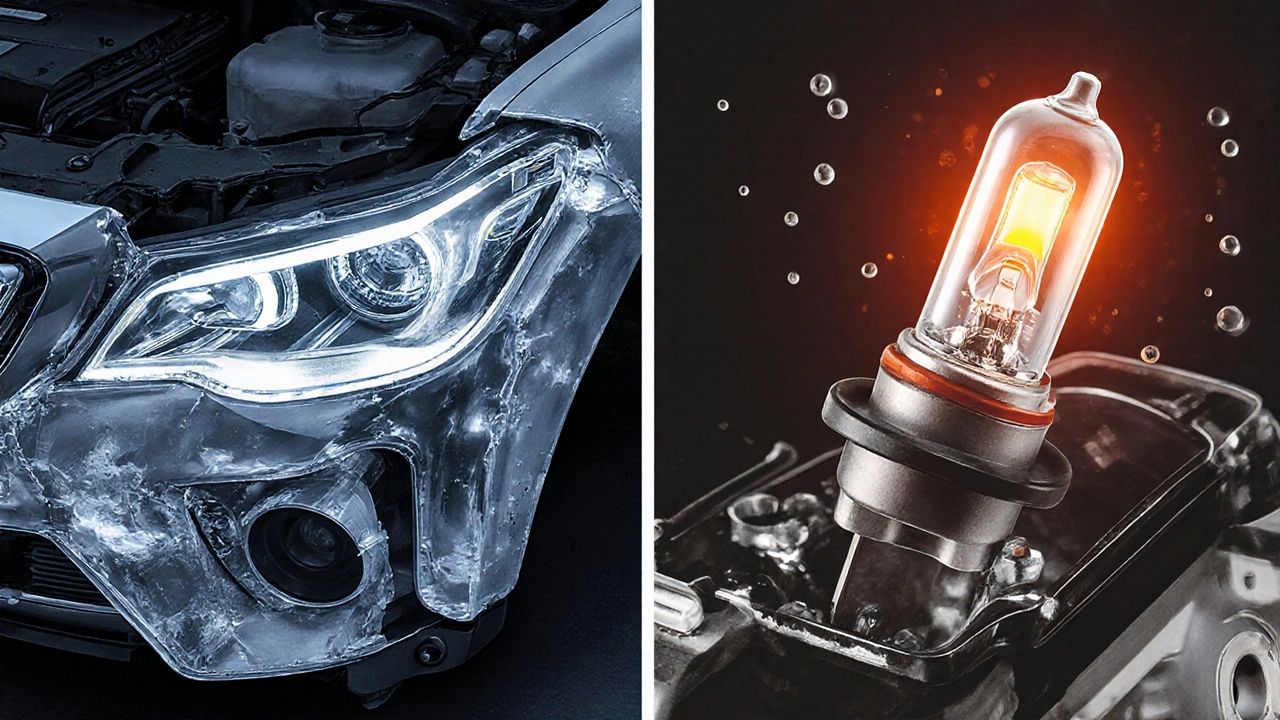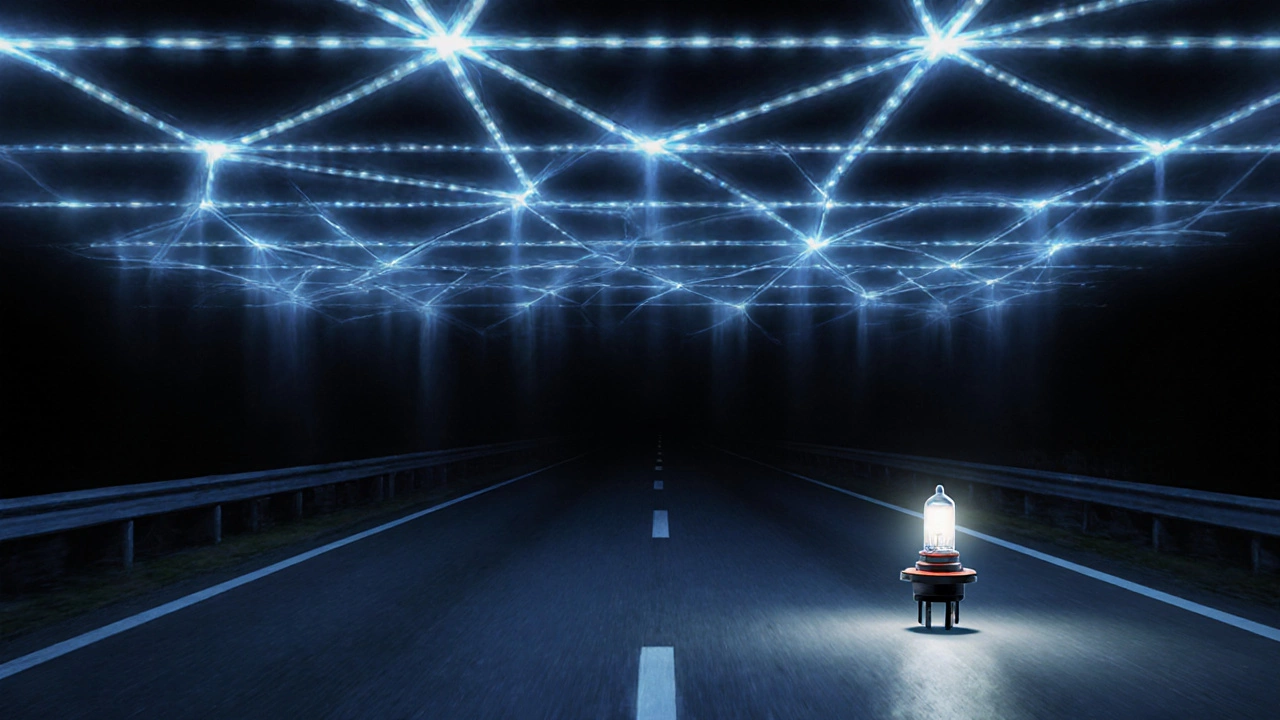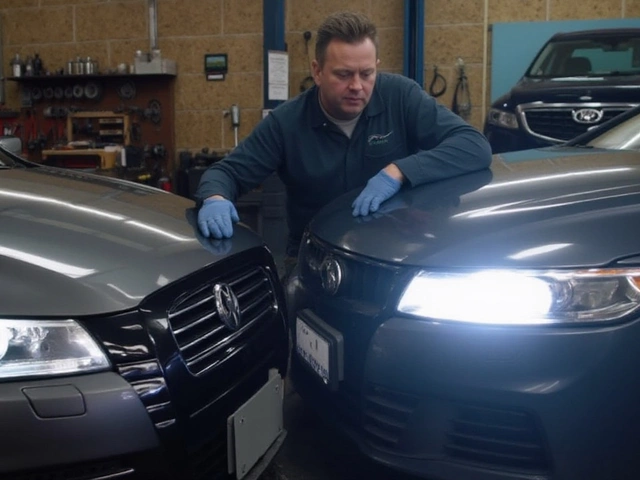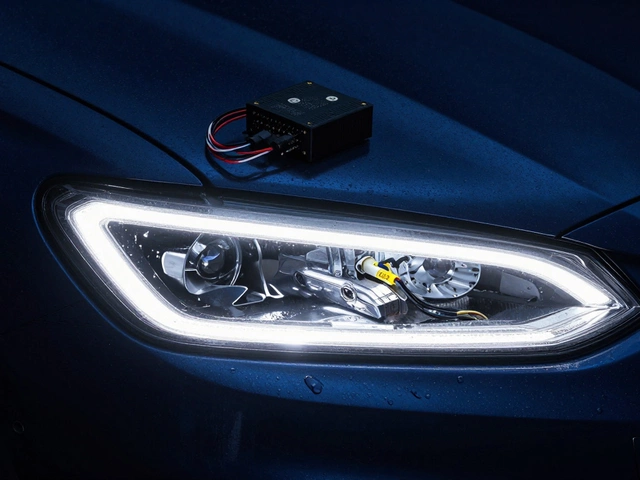LED Headlight Glare Risk Calculator
Based on real-world data from the Australian Road Research Board (2023), this tool calculates your risk of causing glare to other drivers based on your headlight type, alignment, and driving conditions. High glare risk means you may cause temporary blindness for oncoming drivers.
Risk Assessment
Your headlight setup is being evaluated for safety compliance.
LED headlights look sharp. They’re brighter, last longer, and use less power than old halogen bulbs. But if you’ve ever been blinded by an oncoming car at night, or noticed your new LED headlights fogging up inside the lens, you know they’re not perfect. Two big problems keep popping up in real-world use: glare and heat management.
Glare: When Brightness Becomes a Hazard
LED headlights are so intense that they can blind other drivers-even when properly aimed. This isn’t just about bad installation. The problem starts with the light source itself. LEDs produce light from a tiny, super-bright point. Unlike halogen bulbs, which glow evenly across a filament, LEDs emit light in a concentrated beam. When paired with reflectors or lenses designed for older bulb types, that intense point source scatters light in unpredictable ways.
Many aftermarket LED kits don’t come with proper projectors. They just drop the LED bulb into a housing made for halogen. The result? Light spills upward and sideways, hitting the eyes of drivers ahead. In Australia, where rural roads are common and oncoming traffic can appear suddenly, this isn’t just annoying-it’s dangerous. A 2023 study by the Australian Road Research Board found that 38% of drivers reported temporary blindness after encountering poorly installed LED headlights, even on low beam.
Even factory-installed LED headlights on newer cars can cause issues. Some manufacturers use too much blue-rich light to make the beam look ‘crisp’ or ‘premium.’ Blue light scatters more in the human eye, making it harder to focus on the road ahead. This is why older drivers, whose eyes take longer to adjust to bright light, often complain the most.
Heat Management: The Silent Killer
People assume LEDs run cool. That’s true for the bulb itself-but not for the whole system. The LED chip doesn’t get hot, but the driver circuitry behind it does. And that heat has nowhere to go if the housing isn’t built for it.
Factory LED headlights have heat sinks, fans, and thermal pads designed to pull heat away from the electronics. Aftermarket kits? Often they come with a tiny aluminum plate and no airflow. Over time, that heat builds up. It warps the plastic housing. It melts solder joints. It kills the driver board. I’ve seen LED headlights fail after just 18 months because the heat had nowhere to escape.
And here’s the twist: when the heat builds up, it doesn’t just kill the light. It causes condensation. Moisture gets trapped inside the lens because the housing expands and contracts with temperature swings. Fogging inside the headlight isn’t a leak-it’s a thermal failure. You clean the outside, but the inside stays cloudy. That’s not water damage. That’s poor engineering.
Even high-end vehicles aren’t immune. A 2024 report from a Melbourne-based auto electrician showed that 22% of LED headlight replacements on 2020-2024 models were due to heat-related failures, not bulb burnout. The fix? Often a full housing replacement. That’s expensive.

Why This Matters More Than You Think
These two problems-glare and heat-are connected. A poorly cooled LED driver can dim or flicker, forcing drivers to turn up brightness to compensate. That makes glare worse. A headlight that’s too hot might shift its beam angle slightly over time, misaligning the light pattern. You think you’re improving safety, but you’re actually making it worse.
And here’s the irony: LED headlights are supposed to reduce energy use and extend life. But when they fail early because of heat, or cause accidents because of glare, the cost isn’t just financial. It’s safety. In Victoria, headlight glare complaints to road safety authorities rose 41% between 2022 and 2024. Most of those complaints cited LED upgrades.
What Can You Do?
If you’re thinking about upgrading to LED headlights, here’s what actually works:
- Buy OEM replacements only. If your car came with halogens, stick with halogens-or upgrade to certified LED kits that come with proper projectors and thermal management.
- Look for ECE R128 or SAE J1383 certification. These standards test for glare control and durability. Cheap bulbs from eBay rarely meet them.
- Get professional installation. A $100 LED kit installed wrong can cost you $800 in repairs.
- Check your alignment. Even factory LEDs can drift over time. Get them checked during your next service.
Don’t assume brighter means better. Sometimes, the best headlight is the one that doesn’t blind the person coming the other way.

When LED Headlights Are Worth It
There are cases where LEDs make sense. If your car came with factory LEDs, keep them. They’re engineered as a system. If you’re buying a new car with LEDs, you’re getting a balanced design. The problem isn’t LED technology-it’s retrofitting it into systems not built for it.
Stick with halogen or high-quality halogen replacements like xenon HID (if legal in your area) if you’re upgrading an older car. They’re cheaper, easier to replace, and far less likely to cause glare or heat damage.
Are LED headlights illegal?
Not all LED headlights are illegal, but many aftermarket LED kits are. In Australia, any headlight modification must meet ADR 48/04 standards for beam pattern and intensity. Most plug-and-play LED bulbs fail this test because they don’t match the original bulb’s shape and light distribution. If your LED headlights cause glare or scatter light improperly, you can be fined and fail your vehicle inspection.
Why do LED headlights fog up inside?
Fogging inside LED headlights is usually caused by heat cycling, not leaks. The LED driver generates heat that expands the housing. When the lights turn off, the housing cools and contracts, pulling in moist air. If there’s no proper venting or seal, that moisture condenses on the inside of the lens. Factory headlights have breather tubes to handle this. Aftermarket kits rarely do.
Do LED headlights last longer than halogen?
The LED chip itself can last 20,000 to 30,000 hours. But the driver electronics-what actually powers the LED-often fail first, especially in poorly designed kits. In real-world use, many aftermarket LED headlights last only 2-4 years before the driver burns out. Halogen bulbs last 450-1,000 hours but cost less than $20 to replace. The longevity claim only holds if the whole system is engineered properly.
Can I fix LED headlight glare myself?
If the glare is caused by misalignment, yes-get your headlights professionally adjusted. But if the problem is caused by using the wrong housing or a non-certified bulb, no. You can’t fix poor optical design with a screwdriver. The only real fix is replacing the entire unit with a compliant LED or returning to halogen.
Are LED headlights more expensive to repair?
Yes. A single halogen bulb costs under $30. Replacing a failed LED headlight assembly can cost $800-$1,500 per side, especially if it’s integrated with sensors or adaptive lighting. Heat damage often means the whole unit needs replacement, not just the bulb. That’s why many mechanics recommend sticking with halogen unless you’re buying a new car with factory LEDs.
Final Thought
LED headlights aren’t bad. They’re just not magic. They’re a tool-and like any tool, they need the right setup. Pushing a high-tech component into an old system without redesigning the whole housing is asking for trouble. Glare and heat aren’t bugs-they’re design flaws waiting to happen. If you want better lighting, choose wisely. Don’t just go for the brightest option. Go for the one that keeps everyone on the road safe.




